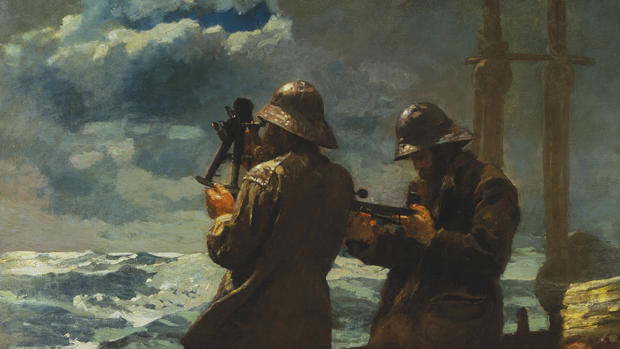Opening the door to Winslow Homer's home and art
(CBS News) Winslow Homer was one of America's best-known landscape painters in the 19th century. And to this day, his work is in a class of its own. With Rita Braver, we pay a visit to his studio:
If any painter has captured the rugged beauty of Maine's coast - the thrilling play of water and light against rock - it has to be Winslow Homer.
"He's a realist and he's a naturalist," said Mark Bessire, director of the Portland Museum of Art. "He's interested in telling you about the power of nature in a single wave. He wants you to feel the spray, be in that painting itself."
And though many of us are familiar with what Winslow Homer painted, until now, we haven't had a chance to see WHERE he painted many of his masterworks: his studio on Prout's Neck, just a few miles outside Portland, where he lived and worked from 1893 until his death more than a quarter century later.
"He could walk down to the cliff walk, see what he needed to see, sketch, come back up here and then paint in the studio," said Bessire.
The museum has just finished a five-year, $2.8 million renovation of the studio - now open to the public for the first time. It was purchased directly from Homer's great-grand nephew.
"The family never wanted to adjust it more than it would to move away from the feeling of Winslow Homer," said Bessire.
Homer etched his name into one of the windows. His pipe is here, along with a sign he posted outside the house that helps explain his reputation as a character and a curmudgeon. Bessire said, "Basically it's code: Don't bother me. Don't come in. I don't want to talk to you."
Winslow Homer was born in Boston in 1836. His father was a businessman, his mother a watercolorist who painted plates that hang in the studio.
Homer got his start as a combat artist, working for Harper's Weekly during the Civil War. One of his first paintings, "Sharpshooter," was originally an etching that he turned into a painting.
Before he settled in Maine, Homer lived and worked in New York, and studied in Europe, too, but his work was always distinctly American.
The painting "Artists Sketching in the White Mountains" shows his sense of humor: "He creates a painting of himself painting a mountain, and then another artist painting the mountain, and then another, and so it's kind of a caricature of the tourist industry beginning," Bessire said.
Other early works, like "Snap the Whip" and "Breezing Up," celebrated the joys of everyday life.
"If you look back and think about, you know, who was truly the first artist to represent these things that were American, whether it's subject matter, the way in which he'd paint, the way in which he lives his life? He is that quintessential person."
But it was the coast of Maine, where Winslow Homer moved in his late 40s, that transformed him into the artist we know today. He ended up here because his older brother Charles, a real estate developer, purchased land on Prout's Neck to build a family compound.
Winslow Homer chose the Carriage House for his home and studio, and had it moved to a spot next door, where he could study the ocean's moods.
To celebrate the Studio's opening, the Portland Museum has mounted a new exhibit devoted to the work Homer produced at Prout's Neck, including "Weatherbeaten." "Every time you go to it, there's something new in the sky, there's something new in the wave - and there's nothing between you and that painting."
But not all of his masterworks are ocean-themed. "Fox Hunt," painted in 1893, is full of foreboding, and seems to suggest that the old fox represents the artist himself.
Bessire says many consider "Fox Hunt" one of the top 10 American paintings of all time. "Usually the fox is the hunter, in this case, the crows are hunting the fox. Many people think it's him thinking, looking at the end of his life."
Homer died in 1910.
"The is the key to the life," said Bessire. "I mean, he did die in the studio, and whether or not he died directly on this daybed, this is always thought of where he died, in in this space. Worth preserving."
This whole studio is a fitting tribute to an American Master.
"I think he surpasses just art history - it's about culture, and maybe that's what makes him bigger than many artists, because it's not just the visual arts. He's part of our psyche, I think, as Americans."
For more info:
- "Weatherbeaten: The Late Art of Winslow Homer ", Portland Museum of Art, Portland, Me. (through December 30, 2012) Tours of Winslow Homer's studio on Prout's Neck are limited to small groups and can be arranged through the Portland Museum of Art
- Bowdoin College Museum of Art, Brunswick, Me.
- National Gallery of Art, Washington, D.C.
- Metropolitan Museum of Art, New York

